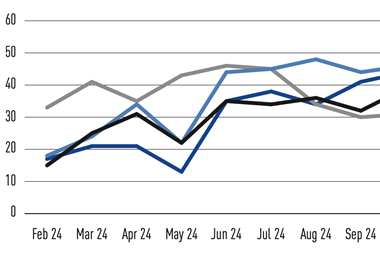Emerging markets are on a roll, but investors remain sceptical. Batterymarch Financial Management attempts to dispel the misleading perceptions that underlie this lack of confidence
Emerging equity markets have been staging a comeback since the end of third quarter of 1998. Yet many investors are not convinced that this recovery is sustainable; they remain sceptical of the benefit of investing further in these markets, particularly since the MSCI Emerging Markets Free Index has already risen 50% in the past 12 months.
The question of whether to invest in emerging markets equities is a contentious one. Investors have seen the value of their emerging markets portfolios roiled by a series of devaluations, multiple contractions and earnings surprises. Understandably, there is much uncertainty about the attractiveness of these markets. Many of the concerns are based on a number of perceptions:
Perception 1: Emerging markets have advanced too much in the past 12 months for investors to expect high returns going forward. Investors have ‘missed the market’.
Reality: The earnings growth we have been seeing in emerging markets should continue. While valuations in many markets have returned to previous levels, the spreads relative to developed markets are as wide as they were a year ago, during the last trough in emerging markets prices.
The MSCI EMF Index has risen 50% in the past year, with a 30% increase since year-end 1998, and the market is currently trading at an index level of 400. This is 20 to 25% below the trading levels for 1995, 1996 and 1997 (see Chart 1). (These measures don’t take into account the prospects for earnings expansion in Asia, which has begun its recovery, and Latin America, which is poised for an upswing, as analysts do not fully believe the recovery story.) There is, in addition, a significant disparity in emerging markets valuation multiples relative to those in developed markets. Furthermore, growth projections are increasing for emerging markets while rapidly decreasing for US and European equities.
Based on our earnings growth forecasts, which are constructed from the bottom up by aggregating forecast earnings of individual companies in our research universe, we believe the valuation disparity is too great (see Chart 2).
The growth to forward P/E of emerging markets stocks is at its widest relative to developed markets since the middle of this decade. The question is whether the riskiness of earnings in emerging markets requires this level of risk premium to justify the gap between stocks in emerging and developed markets. We do not believe it does.
Perception 2: Emerging markets no longer provide diversification benefits in a global portfolio.
Reality: While emerging markets correlations to developed markets have risen, the overall correlations of 0.69 to the US and 0.6 to Europe still provide ample diversification.
The market contagion experienced by global investors from mid-1997 through the third quarter of 1998 was so disheartening that many believe emerging markets no longer offer diversification.
We examined correlation statistics from several perspectives. The first, in which we studied the last 10 years, provides sufficient monthly time-series data to yield statistically significant results (seeTable 1). The correlations of emerging markets to a US, European or UK investor are similar, ranging from 0.51 to 0.55. However, these investments have provided greater diversification than investments in other developed markets.
Some would argue, though, that the events of the past three years have negated this trend, suggesting that correlations among markets have increased permanently due to the globalisation of economies. Therefore, we also calculated correlations for the past three years. However, we regard the results with appropriate caution because of the limited data points; the conclusions should be considered indicators of the direction that longer-term studies would provide (see Table 2). Indeed, correlations of emerging markets to US, European and UK investors are higher during the recent past, ranging from 0.61 to 0.72.
Not surprisingly, the correlations are highest for a US investor, partly due to the large increase in correlations between the US and Latin American markets, as these markets and economies have become increasingly integrated. However, the more recent data shows that all developed markets have higher correlations with each other. While the case for diversification is weaker today than in the past, emerging markets still appear to provide better diversification benefits to European and UK investors than do other developed markets.
A final concern for investors is that emerging markets would be very vulnerable to a US economic slowdown or market decline. This thinking is based on two facts: emerging markets prices are strongly influenced by US investor portfolio flows, and earnings in these markets increasingly depend on exports to the strong US economy.
Because investors are mainly concerned about the lack of diversification in down markets, we also examined the behaviour of emerging markets when the US market was falling (see Table 3). And, indeed, we found much higher correlations during these periods than when the market was rising. This, of course, is readily explainable by the 10-year bull market in the US, while emerging markets endured various crises during the period.
We found that market moves, especially in Latin America and Asia, were closely tied to the US, particularly when major regional markets such as Mexico were dropping. This can probably be attributed to the influence of money flows from US investors, through both mutual funds and the proprietary trading desks of global investment banks, as well as through commercial lending activities.
Emerging markets are more highly leveraged to changes in money flow than any other part of the world. Thus interest rate increases, which can be expected to knock down market values in the developed world, have a significant impact on funding to emerging markets – one of the principal drivers of their growth.
However, the results clearly indicate that the diversification benefits of emerging markets declined more for US investors than for European investors. Curiously, UK investors have retained their diversification benefits even through US market declines.
While the diversification benefits of emerging markets are less strong today and probably vulnerable to a US market decline, emerging markets continue to provide important diversification for developed-market investors.
Perception 3: Asia will not regain its strength without an recovery in Japan.
Reality: The Asian recovery was underway even before Japan started its uphill climb.
Asia cannot be divided into developed and emerging countries in assessing its outlook because all the Asian economies have been inextricably linked by the growth of intraregional trade. It is true, however, that Japan is more dependent on the rest of Asia than Asia is on Japan. Japan accounts for only 11.7% of all Asian exports, while Asia, excluding Japan, imports 19.6% of all Japanese exports.
The Asian crisis is seen as a clear illustration that all of the countries in the region absolutely depend on each other for their economic health. During late 1997 and 1998, economic contagion was responsible for pressure on currencies and skyrocketing interest rates across Asia. The consequential rapid fall into recession hurt not only the smaller, less-developed countries, but also China, Japan, Hong Kong and Australia. Without their trading partners to stimulate growth, these countries saw a collapse of their export markets, leading to a drop in domestic demand.
In most of the smaller economies, the V-shaped recovery is in progress despite the fact that Japan and China – Asia’s two ‘supertankers’ – continue their struggle against deflation. Improving domestic economic growth in countries such as Korea, Malaysia and Thailand is supporting a rise in intraregional trade (see Table 4). With Japan’s high dependency on Asian trade, it is actually the recovery in Asia, combined with the domestic stimulation package, that is pulling Japan out of recession.
Capacity utilisation, which in many cases had fallen to about 30%, is rising rapidly in Asian emerging markets. This increase is improving cash flow and dramatically affecting profits as debt-heavy balance sheets go from loss to profit. It is still a little early for improving cash flow and profits to spark a further round of capital expenditure, but this is likely to happen after the year 2000, when it should provide a second chapter to the regional growth story.
Meanwhile, one should not underestimate the effect of the technology cycle on Asia. The electronics sector is extremely important to the entire region, but its effect has been hidden in markets such as Thailand, Malaysia, Philippines and China, where much of the producing assets are either unquoted or are subsidiaries of large multinational corporations. For example, technology goods now represent nearly 60% of Malaysia’s exports.
Nonetheless, the dramatic recovery in demand, coupled with the decrease in an oversupply of goods, has produced some very strong export figures. Ongoing technology innovation, particularly in the area of microchips, is expected to bring the price point for internet connection hardware, namely internet computers, down to $300 by March of next year. The improved demand that follows will have an enormous impact on the Asian recovery.
Of course, some countries in Asia do not trade significantly with Japan. India is the largest of such markets. Because Indian holdings are a prominent component of most emerging markets portfolios, India’s very positive outlook increases the attractiveness of Asia as a whole regardless of Japanese economics.
The Indian market’s expected strength is based on several factors: a strong earnings recovery, improving capital efficiencies, favourable supply and demand for equities and rapidly improving market systems. The recent recovery in India’s economic cycle, particularly in the industrial sector, should get a further boost through a turnaround in the capital investment cycle, which could be triggered by the formation of a relatively stable new government in October. In addition, agriculture has been very strong in the past few years and has led to an improvement in consumer demand.
Perception 4: Industrial production in emerging markets will shut down because companies are unprepared for Y2K.
Reality: The impact of Y2K on emerging markets companies should be manageable because the larger, well-established companies generally favoured by global investors have implemented compliance programmes similar to those in the developed world.
In addition to fundamental considerations, investors are concerned about the readiness of emerging markets companies for the end of the millennium. However, the larger, more successful companies – those most likely to be found in global portfolios – have established Y2K compliance programmes comparable to those in developed markets.
Smaller, less mature companies in emerging markets tend not to depend on computers as extensively. Many of them have been late to computerise their operations. The cost of hardware even at the beginning of the 1990s was so high relative to the ability of most of these companies to use it effectively that many opted to do without. Only with the continued decline in the price of computing power has it been feasible for relatively poor companies to use computers. In addition, these companies often find it cheaper to hire additional employees to enhance productivity rather than invest in training their workers in computer skills.
Thus even smaller publicly traded companies in the private sector generally seem prepared for Y2K by reason of their limited or recent computerisation. Furthermore, our meetings with managements, as well as
surveys by the research departments in a number of investment banks, suggest that most emerging markets companies have their Y2K solutions well in hand.
What is much more difficult to assess as the century draws to a close is the potential impact of public utilities on emerging markets companies. Significant doubts about the Y2K readiness of public utilities seems to be heightening risk aversion among investors from developed markets. This might explain the current premium for liquidity in emerging-markets stocks versus developed-market issues. If sudden panic develops, we expect it to present an excellent buying opportunity.
The next perception
As we look forward to the coming years, we are more likely to see enthusiasm for emerging markets than disgruntlement. The next story about emerging-markets investing – once the market has climbed another 50% – may well be that these markets offer the hottest technology plays outside the US.
While this idea may seem farfetched, it has a kernel of truth. Companies in South Korea and Taiwan provide many of the electronic components for the world’s personal computers. And Indian companies provide much of the software engineering needed to integrate computer systems.
As the price of computers and Internet connectivity drops and this technology becomes a staple for households in both the developed and emerging worlds, suppliers of computer components and peripherals should participate in one of the great revolutionary expansions of the early 21st century. Because emerging markets hold such a large share of the computer-components and assembly market, companies in these regions could again be flooded with money just as they have been from time to time in the past.
A buying opportunity
The prevailing view among emerging markets investors generally ranges from cautious to fearful. As a result, the widespread perceptions discussed above tend to exaggerate the negative case for emerging-markets equity investing. We believe, however, that the crisis of the past two years has in fact offered valuable lessons to many of these markets and that the changes now being implemented make the case for emerging markets even stronger than before the crisis.
In many markets, where we are witnessing much-needed reform and the correction of the excesses that have existed, we anticipate sounder business practices going forward. The case for growth in emerging markets remains valid, and we believe that the risk premium will narrow as investor confidence is restored.
Several members of the emerging markets team at Batterymarch Financial Management in Boston contributed to this analysis












No comments yet